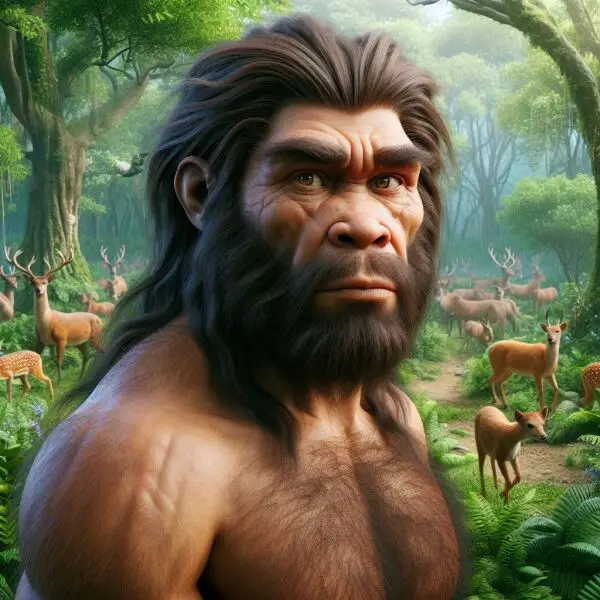Humans almost disappeared 930,000 years ago
930,000 years ago, a drastic climate change almost wiped us off the map. A genetic bottleneck put us in check! Can you imagine?...
Table of Contents
- The Genetic Bottleneck: When Humanity Was on the Brink
- A Puzzle in Evolutionary History
- Chromosome 2 and Human Evolution
- Modern Technology to Discover the Past
Follow Patricia Alegsa on Pinterest!
The Genetic Bottleneck: When Humanity Was on the Brink
Imagine a world where humanity was on the verge of disappearing, and no, I'm not talking about a science fiction movie. Almost a million years ago, our ancestors faced a titanic challenge.
Extreme climate changes, like ice ages that made even the bravest penguin tremble and droughts that left throats dry, threatened to wipe our species off the map. However, a small, somewhat stubborn group managed to cling to life. This group became the genetic foundation of modern humanity. What a way to start a success story, right?
Scientists from around the world, armed with computers and an insatiable curiosity, discovered that between 930,000 and 813,000 years ago, the population of our ancestors was reduced to about 1,280 reproductive individuals. Imagine a neighborhood party, but instead of neighbors, there are just a few distant relatives.
Scientists from around the world, armed with computers and an insatiable curiosity, discovered that between 930,000 and 813,000 years ago, the population of our ancestors was reduced to about 1,280 reproductive individuals. Imagine a neighborhood party, but instead of neighbors, there are just a few distant relatives.
This situation, known as a "genetic bottleneck," lasted about 117,000 years. And here we are complaining about a bad day! During this time, humanity was on the brink of extinction.
Why is there a lack of fossil evidence of our ancestors in Africa and Eurasia during this period? The answer may lie in the drastic population reduction they experienced. Giorgio Manzi, an anthropologist so passionate that he probably dreams of fossils, suggests that this crisis could explain the scarcity of fossil records from that time. Think about it, if almost everyone disappeared, there wouldn’t be many bones left behind.
This bottleneck occurred during the Pleistocene, an era we might call the diva of geological periods due to its extreme climate fluctuations. These changes not only affected natural resources, such as the food sources our ancestors needed to survive, but also created a hostile environment. Still, our ancestors did not sit around crying over their mammoth hides. They adapted and survived, marking a crucial point in human evolution.
This period was not only a climatic nightmare; it was also a catalyst for significant evolutionary changes. During the bottleneck, two ancestral chromosomes fused to create chromosome 2 that we all carry today. This genetic event may have facilitated the evolution of modern humans, separating them from their cousins, the Neanderthals and Denisovans. Who would have thought that such a small change could have such a big impact!
Moreover, this time of stress may have accelerated the evolution of key characteristics such as the development of the human brain. Yi-Hsuan Pan, an expert in evolutionary genomics, suggests that environmental pressures may have fostered crucial adaptations, such as advanced cognitive skills. Perhaps it was then that we began to think about deeper things than "Where is my next meal?"
To uncover this dramatic chapter in human history, researchers used a computational technique called FitCoal. This technology analyzes allele frequencies in modern genomes to infer changes in the size of ancient populations. In other words, it's like playing genetic detective with cutting-edge software. Yun-Xin Fu, a geneticist who could probably solve any mystery, emphasizes that FitCoal provides accurate results even with limited data.
However, the study raises new questions. Where did these humans live during the bottleneck? What strategies did they employ to survive? Some scientists speculate that the control of fire and the emergence of more hospitable climates could have been crucial for their survival. Imagine the thrill of discovering fire for the first time!
In conclusion, this discovery not only fills a gap in the fossil record but also highlights the incredible adaptability of humans. What happened 930,000 years ago still has implications today. It reminds us that we are fragile but also incredibly resilient. So next time you complain about the weather, remember that your ancestors survived something much worse. And here we are, ready to face it all!
A Puzzle in Evolutionary History
Why is there a lack of fossil evidence of our ancestors in Africa and Eurasia during this period? The answer may lie in the drastic population reduction they experienced. Giorgio Manzi, an anthropologist so passionate that he probably dreams of fossils, suggests that this crisis could explain the scarcity of fossil records from that time. Think about it, if almost everyone disappeared, there wouldn’t be many bones left behind.
This bottleneck occurred during the Pleistocene, an era we might call the diva of geological periods due to its extreme climate fluctuations. These changes not only affected natural resources, such as the food sources our ancestors needed to survive, but also created a hostile environment. Still, our ancestors did not sit around crying over their mammoth hides. They adapted and survived, marking a crucial point in human evolution.
Chromosome 2 and Human Evolution
This period was not only a climatic nightmare; it was also a catalyst for significant evolutionary changes. During the bottleneck, two ancestral chromosomes fused to create chromosome 2 that we all carry today. This genetic event may have facilitated the evolution of modern humans, separating them from their cousins, the Neanderthals and Denisovans. Who would have thought that such a small change could have such a big impact!
Moreover, this time of stress may have accelerated the evolution of key characteristics such as the development of the human brain. Yi-Hsuan Pan, an expert in evolutionary genomics, suggests that environmental pressures may have fostered crucial adaptations, such as advanced cognitive skills. Perhaps it was then that we began to think about deeper things than "Where is my next meal?"
Modern Technology to Discover the Past
To uncover this dramatic chapter in human history, researchers used a computational technique called FitCoal. This technology analyzes allele frequencies in modern genomes to infer changes in the size of ancient populations. In other words, it's like playing genetic detective with cutting-edge software. Yun-Xin Fu, a geneticist who could probably solve any mystery, emphasizes that FitCoal provides accurate results even with limited data.
However, the study raises new questions. Where did these humans live during the bottleneck? What strategies did they employ to survive? Some scientists speculate that the control of fire and the emergence of more hospitable climates could have been crucial for their survival. Imagine the thrill of discovering fire for the first time!
In conclusion, this discovery not only fills a gap in the fossil record but also highlights the incredible adaptability of humans. What happened 930,000 years ago still has implications today. It reminds us that we are fragile but also incredibly resilient. So next time you complain about the weather, remember that your ancestors survived something much worse. And here we are, ready to face it all!
Subscribe to the free weekly horoscope
Aquarius Aries Cancer Capricorn Gemini Leo Libra Pisces Sagittarius Scorpio Taurus Virgo
-
 Artificial Intelligence is becoming increasingly intelligent and people are becoming increasingly foolish
Artificial Intelligence is becoming increasingly intelligent and people are becoming increasingly foolish
As Artificial Intelligence becomes increasingly smarter, capable of creating incredible art, people seem to be getting dumber. What can we do about it? -
 Influencer had sex with 101 men and could also be banned from Airbnb
Influencer had sex with 101 men and could also be banned from Airbnb
OnlyFans model Lily Phillips, famous for her love marathon, could be banned from Airbnb for breaking the rules! Scandal looming! -
 India Wants to Further Increase Its Population Why?
India Wants to Further Increase Its Population Why?
India, the most populous country, faces a dilemma: it needs more babies! Aging and low birth rates jeopardize its economic and political future. -
 Armie Hammer: From Rising Heartthrob to Falling Due to Shocking Scandals
Armie Hammer: From Rising Heartthrob to Falling Due to Shocking Scandals
Armie Hammer, former Hollywood star, faces serious allegations of abuse and cannibalism that have destroyed his career. Today he turns 38. -
 Why do airplanes avoid flying over Tibet?
Why do airplanes avoid flying over Tibet?
Discover why airplanes avoid flying over Tibet, a region that reaches over 4,500 meters in altitude, complicating commercial flights.
I am Patricia Alegsa
I have been writing horoscope and self-help articles professionally for over 20 years.
Subscribe to the free weekly horoscope
Receive weekly in your email the horoscope and our new articles on love, family, work, dreams and more news. We do NOT send spam.
Astral and numerological analysis
-
 Discover your future, secret personality traits and how to improve in love, business and life in general
Discover your future, secret personality traits and how to improve in love, business and life in general
-
 Online Dream Interpreter: with artificial intelligence
Do you want to know what a dream you had means? Discover the power of understanding your dreams with our advanced online dream interpreter using artificial intelligence that responds to you in seconds.
Online Dream Interpreter: with artificial intelligence
Do you want to know what a dream you had means? Discover the power of understanding your dreams with our advanced online dream interpreter using artificial intelligence that responds to you in seconds.
-
 12 years since the kidnapping of a journalist in Syria
12 years since the kidnapping of a journalist in Syria
12 years since the kidnapping of journalist Austin Tice in Syria. The U.S. demands his release after he was captured on August 14, 2012, in Damascus. -
 What the characters from the Friends series would look like at 5 years old
What the characters from the Friends series would look like at 5 years old
Artificial intelligence has been used to transform the iconic Friends characters into characters as young as 5 years old. -
 Extreme Challenge: Influencer Ate 24 Eggs Daily and Revealed His Cholesterol
Extreme Challenge: Influencer Ate 24 Eggs Daily and Revealed His Cholesterol
Nick Norwitz ate 24 eggs daily for a month to analyze their impact on cholesterol, challenging WHO recommendations. Surprise! -
 Is it true that we should wait to swim after eating?
Is it true that we should wait to swim after eating?
Should we wait 2 hours after eating before swimming? Discover what science says about the famous myth of 'digestion interruption' that intrigues us every summer. ?♀️? -
 Incredible! Travel with the best 360-degree view on this exclusive plane
Incredible! Travel with the best 360-degree view on this exclusive plane
They have designed a plane with an exclusive view that not even the aircraft captains can access. Discover it in this video! -
 Discover your personality according to the seat you choose: Dare to get to know yourself!
Discover your personality according to the seat you choose: Dare to get to know yourself!
What does your choice of seat say about your personality? From the hard plastic chair to the most comfortable bean bag, discover the 11 types of seats and what they reveal about you. Take the test and be surprised! -
 Incredible! Statue of the Virgin Mary wept blood, but DNA revealed to whom it belonged
Incredible! Statue of the Virgin Mary wept blood, but DNA revealed to whom it belonged
Gisella Cardia faces trial in Italy: a statue of the Virgin Mary 'wept' her blood, according to a DNA analysis that matches her genetic profile. -
 Ryan Phillippe at 50: the living proof that age is just a number!
Ryan Phillippe at 50: the living proof that age is just a number!
If you ever doubted that turning fifty could be sexy, masculine, and attractive, then you clearly haven't seen Ryan Phillippe lately. -
 What does it mean to dream of bombs?
What does it mean to dream of bombs?
Discover the meaning of dreaming about bombs and their relation to your emotions and decisions, don't miss this complete guide to interpret your dreams! -
 What does it mean to dream of axes?
What does it mean to dream of axes?
Discover the possible meanings of dreaming about axes in this article. Does it represent a threat? Is it a symbol of strength? Find out here! -
 Discover what drives you to risk it all according to your zodiac sign
Discover what drives you to risk it all according to your zodiac sign
Discover how the choices that define your past and future relate to your Zodiac. What risks would you dare to take? Find the answer here. -
 How to Naturally Increase Serotonin and Feel Better
How to Naturally Increase Serotonin and Feel Better
Discover how to naturally increase the 'happiness hormone.' Nutrition and laughter are key to elevating serotonin and improving your well-being. -
 You should stop cooking with aluminum foil: it's toxic!
You should stop cooking with aluminum foil: it's toxic!
You should stop cooking with aluminum foil and I'll explain why in this article. Also tips for replacing it.